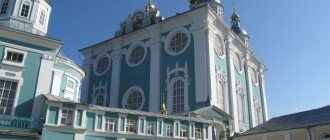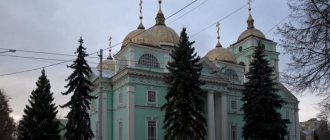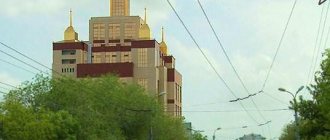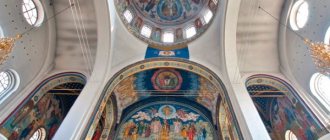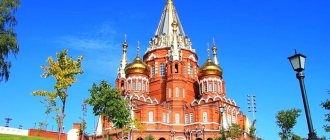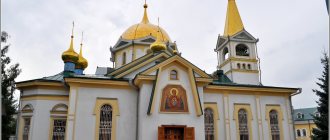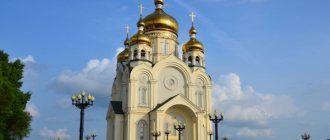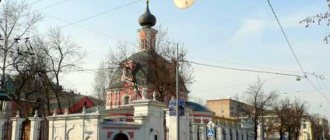The Assumption Cathedral was built on the territory of an ancient fortress, surrounded by many defensive ramparts. Currently, this medieval building is known as the Town. The first stone in the construction of the temple was laid in the 15th century.
For 400 years from the moment of construction, the Assumption Cathedral stood unchanged and was not subject to destruction or architectural reconstruction. Only at the beginning of the nineteenth century. Moscow craftsmen added an additional belfry.
The Assumption Cathedral is considered one of the oldest churches in Russia, and the building itself is protected by national legislation as an object of national heritage.
Address of the Assumption Cathedral on Gorodok in Zvenigorod
The Assumption Cathedral of the Blessed Virgin Mary is located in Zvenigorod, 65 km from Moscow. This shrine has a separate address: st. Town, 1. The shrine is located on a high hill away from other religious buildings, but is surrounded by private residential buildings.
Assumption Cathedral in Zvenigorod
The area on which the cathedral was built previously had important military and tactical significance. The Church of the Assumption of the Virgin Mary is actually outside the city limits. The main landmark in the search for the shrine is the Church of Alexander Nevsky, located to the left of the Assumption Cathedral.
Recovery
In 1998, the spiritual revival of Zvenigorod began. On the site of the Ascension Cathedral, a small chapel was built in which there was an icon of the Ascension of the Lord.
In 2003, the foundation stone for the new Ascension Cathedral in Zvenigorod was completed. According to the decision of the authorities, the temple had to be built on its historical site.
In the summer of 2007, the newly rebuilt cathedral in honor of the Ascension of the Lord was consecrated. On the same day the first Divine Liturgy was celebrated.
The new temple has the same three aisles as its predecessor. But in architectural design it is completely different. The current building of the cathedral is a four-pillar, five-domed building, made in the neo-Byzantine style.
Before the construction of the temple, during the examination of the hill, multiple ancient burials with remains were discovered. And in 2007, while installing a water supply to the temple, the remains of a clergyman were found, presumably Archpriest Nicholas of Fivey, who was the rector of this cathedral from 1853 to 1886.
All the remains were buried on the eastern side of the temple during a memorial service.
How to get there by car
You can get to the Assumption Cathedral on your own using a car.
To do this you need to follow the route:
- Leave Moscow on Mozhaiskoye Highway in the direction of the village of Bolshie Vyazemy.
- Having reached Bolshie Vyazi, you need to turn right towards Zvenigorod. There is a corresponding sign at this location.
- Drive through the entire urban area to the Alexander Nevsky Church, which looks like a monumental white building.
- Near this temple you need to change lanes to the right and then leave the city.
- Continue moving along the Moscow River.
- On the right side of the road on the hill there is an equipped source with holy water, near which you need to make a stop.
Directly near the spring itself, a staircase begins that goes to the top of the hill. Then the path must be continued on foot. Climbing this staircase, the traveler gets straight to the Assumption Cathedral.
Seasonality of tourism in Zvenigorod
The close distance from Moscow allows you to visit Zvenigorod at any time of the year. New Year, Maslenitsa and major religious holidays are also celebrated here. During school holidays, numerous children's groups come to the city. The Miracle Park entertainment complex is closed from October to early May. But for lovers of outdoor activities, ski slopes and gentle mountain slopes await you.
The low hills of Zvenigorod near Moscow are suitable for children and beginner ski lovers
In the picturesque surroundings of the city, wealthy Muscovites built houses for summer living, many of which became sanatoriums and boarding houses during the Soviet era. For example, the Zvenigorod sanatorium is located in the former Sheremetyev estate. It is located a few minutes drive from the Zvenigorod station, is equipped with modern equipment for recreation and health promotion, has a mineral water source, a swimming pool, a beach, a ski slope on its territory and welcomes everyone all year round.
The first building of the Zvenigorod sanatorium was the historical estate of the Sheremetyev counts
Video: recreation and recreation opportunities in the vicinity of Zvenigorod
How to get there by public transport
The Assumption Cathedral in Gorodok is open to visitors throughout the year.
To get to the temple by public transport, it is recommended to use the train service, and also follow the following procedure:
- Arrive at the Belorussky railway station in Moscow.
- Take an electric or diesel train that stops at Zvenigorod station.
- Get up at this train station.
Upon arrival in Zvenigorod, at the station square you need to take a tourist bus, which transports citizens to the Assumption Cathedral, or use a taxi. The average distance from the Zvenigorod railway station to the Church of the Assumption of the Blessed Virgin Mary is 3 km.
People who are in good physical shape can cover this distance on foot. If you maintain an average walking pace, it will take no more than 30 minutes.
Recreation and entertainment for parents with children
For travelers with children, Zvenigorod offers several places for educational and active recreation.
- The Museum of Russian Dessert will be of interest to visitors of any age. Kids will be delighted with sweets made according to traditional recipes and will be able to practice their culinary skills.
- The museum’s exhibition “Back to the USSR” will surprise teenagers accustomed to mobile phones and computers with examples of home appliances from the last century.
- The historical, architectural and art museum in the Savvino-Storozhevsky Monastery will introduce young visitors to the traditional design of the royal and boyar chambers of the 17th century.
- "Miracle Park" - a new children's entertainment complex in Zvenigorod invites all lovers of active entertainment in nature. There is everything here: trampolines and playgrounds for the little ones, rope devices for developing strength and agility, sports equipment for adults, a shooting range, a pond and much more. The park is located near the village of Dunino. You can get there by bus No. 13, and then follow the “Miracle Park” sign on foot. Entrance to the park is free, but you have to pay 250 rubles for using each device.
Video: a short walk through the “Miracle Park” of Zvenigorod
History of the temple
The Assumption Cathedral on Gorodok was erected on the orders of Grand Duke Yuri of Zvenigorod, who owned these lands and was also responsible for the defense of these borders from enemies. Construction of the temple was completed in 1400. Currently, several earthen ramparts are still preserved around the shrine, which surround the cathedral from three directions simultaneously.
The construction of the church was entrusted to noble craftsmen from Moscow, known for the construction of the Church of the Nativity of the Virgin Mary. Initially, the Assumption Cathedral did not have a belfry. This element of the temple was built only in the first half of the 19th century.
Immediately after the completion of the belfry, a decision was made to dismantle the chapel created in honor of the holy martyr George. Due to the anti-religious persecution of the communist authorities, the Assumption Cathedral was completely closed to believers in 1930. Beginning in 1946, church services began again in the medieval shrine.
Since the 1990s, the Assumption Cathedral has served as a courtyard for the monks of the Savvino-Storozhevsky Monastery, which was also erected by order of the Grand Duke and district ruler Yuri of Zvenigorod. Currently, services are held in the church on a regular basis.
Soviet time
After the 1917 revolution, the property of the temple was confiscated and nationalized. In 1922, the Ascension Cathedral in Zvenigorod was closed and converted into a room for grain storage. To make it easier to deliver convoys with grain to the building, the wall of the temple on the river side was broken.
In 1939, a garage for buses was located in the premises of the Church of the Ascension. There was also an inspection pit and a metalworking workshop.
Just before the war, in the spring of 1941, the authorities decided to demolish the temple building and use the bricks to build new city buildings.
On the site of the Ascension Church, a monument to J.V. Stalin was erected, which was later demolished. The hill on which the cathedral was located was never developed, although local authorities considered several options for using this area.
The wooden houses belonging to the temple have survived to this day. Over the years, they housed a kindergarten, residential buildings and an ambulance station.
Architect and exterior decoration of the cathedral
The Assumption Cathedral on Gorodok is a 4-pillar church, which has only one dome, located in the center of the building. On the eastern side of the shrine there are 3 altar-type apses. From the south, west and north, the sides of the cathedral are distinguished by a classic division into 3 separate spindles with a vertical structure. The architectural completion of these spinning wheels are the zakomaras.
This is a semicircular completion of the outer part of the wall, which is adjacent to the barrel vault. The vertical division of the facades is made in the form of blades, which are simultaneously adjacent to thinner semi-columns. The last architectural element of the external decoration of the Assumption Cathedral ends with sheaf-shaped capitals.
The altar apses of the Assumption Cathedral are also divided by half-columns, and the wall decor is made using thin vertical rods. A unique element of the external decoration of the temple is a triple ribbon with wide edges, which consists of a floral ornament applied using stone carving.
This type of architectural decoration conventionally divides the cathedral building horizontally. The upper segment of the altar apses, as well as the drum section of the dome, is decorated with a double line with a similar ornament in the form of stone carvings. On the side of the central spindles there are perspective portals, complemented by arched forms and monumental columns.
The original appearance of the window openings, which extend vertically upward, has been preserved only in the upper segment of the side walls, as well as in the area of the central apse. Initially, the roof of the Assumption Cathedral was equipped with a roof covering. The zakomars are a harmonious completion of the temple's spindles and complicate its 4-step top.
At the bottom of the dome drum there is a belt of architectural kokoshniks that perform a decorative function. A distinctive feature of the external decoration of the Assumption Cathedral is that its kokoshniks, portals, windows, as well as zakomaras are keel-shaped.
Architectural ensemble of the cathedral
The Assumption Cathedral on Gorodok was erected by a group of Moscow craftsmen who specialized in the construction of churches. There is no reliable information about the names of the builders and the architect who drew up the design of this temple.
The construction of the Assumption Cathedral was carried out taking into account the general architectural trends that at that time prevailed in the territory of the Vladimir-Suzdal principality. The temple is located on a fairly high basement, and the slight narrowing of its walls creates a slight effect of the stepped arches rushing upward.
The eastern pillars of the cathedral are shifted towards the altar apses, which added volume to the space under the dome.
The external division of the facade of the Assumption Cathedral does not correspond to its internal dimensions. From the inside the temple seems more spacious. As in most other churches of the pre-Mongol era, in the western part of the cathedral there is a separate place for the choir. This element of architecture is absent in other Moscow churches.
The Assumption Cathedral on Gorodok belongs to the category of cross-domed churches. This is one of four white stone churches that have survived in the Moscow region. Nowadays, the original shapes of the openings for the windows and roof of the cathedral have been distorted by several repairs that were carried out in the 19th century.
Savvino-Storozhevsky Monastery
... Turn to the monastery - here you need to get off the bus. It's not a long walk, but uphill. The hike can take about 10 minutes.
The stone walls of the monastery, with round towers and loopholes, look white through the trees - like a fortress. After all, monasteries used to be fortresses and often served a defensive function.
Tsar Alexei Mikhailovich the Quietest loved this place. Once, while hunting in the vicinity of the monastery, he met a bear, and none of the sovereign’s people were nearby. According to legend, an old man suddenly came out of the thicket and pacified the wild beast. “Who are you?” asked Alexey Mikhailovich. “Sava,” answered the monk and disappeared as unexpectedly as he had appeared. Since then, the Tsar regularly came here, even built himself a residence here - the Tsar's palace and the Tsarina's chambers, where the pilgrimage service and the museum are now located, respectively. Scientists say that these white-stone royal chambers are one of the most significant monuments of civil architecture of the mid-to-late 17th century.
The windows of the royal room probably looked out onto the meadows...
And in the chambers where Maria Ilyinichna Miloslavskaya, the wife of Alexei Mikhailovich, once stayed, now there are displays and exhibitions of the Zvenigorod Historical, Architectural and Art Museum. Tiled “antile” stoves, boyar furniture, kokoshniks and earrings - what’s not there! You can stay in the museum for an hour or two.
Interior decoration
Immediately after construction was completed, the inside of the Assumption Cathedral was painted with frescoes depicting the faces of saints and Orthodox martyrs. The creators of the interior decoration of the temple were of aristocratic and court origin. The paintings on the walls of the shrine have survived only in fragments.
For the first time, the interior decoration of the temple was examined in 1918 by the Commission, which was studying ancient Russian painting. The head of the scientific expedition was Nikolai Protasov. Opened walls with images of Christian saints are concentrated in the drum part of the dome, as well as near the altar.
On the pylons in the eastern part of the building, on the surface of the northern wall near the choir, there is also a painting dating back to the 15th century. The rest of the paintings of the temple, which have been well preserved to this day, were painted in the first half of the 19th century, when restoration and partial reconstruction of the temple was carried out.
Initially, images of the forefathers were painted on the inner surface of the drum part of the dome, which were made in 2 tiers. A little lower, the masters of painting depicted Christian prophets, of the total number of which only the figure of St. Daniel has been preserved.
The interior decoration of the Assumption Cathedral combines lightness of draperies, light shades of paint and refined outlines of the feet, hair, and hands of Christian saints.
On the surface of the northern wall of the church there is a fresco discovered by the scientist V. Filatov, which is part of a large iconostasis with the plot of “The Dormition of the Mother of God”. There are 3 drawings on the eastern pylons of the temple. At the top of the pillars are depicted figures of ascetics and martyrs who had the ability to heal people, St. Laurus and St. Florus.
These images, located next to the pre-altar part of the cathedral, indicate to parishioners that a person needs not only treatment of his body, but also spiritual healing. Below the images of St. Laurus and Florus are the Calvary crosses.
On the surface of the northern pylon of the Assumption Cathedral there is a scene of the transfer of the monastic rule from the soaring angel to the reverend abbot Pachomius. On the cover of the southern pillar there is a painting in which the artist talks about the conversation between Barlaam and the king of India, Joasaph.
The interior decoration of the Assumption Cathedral reflects the important role of the forefathers and Christian prophets, and also conveys the greatness of the spiritual feat of the monks, who voluntarily deprive themselves of earthly goods and devote their lives to the service of the Lord.
On the southern pylon there is an image where in Varlaam’s hand there is a package with the following message: “I will tell you about the priceless bead that is Christ.”
Nativity Cathedral of the Monastery
Initially, a wooden church was erected on the site of this temple in 1398–99. All around, you can imagine, there were the same wooden cells and monastery buildings. But just a few years later, in 1404–1405, by order of Prince Yuri and at his expense, the construction of a white-stone cathedral in honor of the Nativity of the Blessed Virgin Mary began. White stone was mined not far from these places - in the upper reaches of the Moscow River.
Around the same time, at the invitation of Prince Yuri of Zvenigorod, Savva left the Trinity Monastery in the Sergius Monastery, where he was at that time abbot, and came to Zvenigorod to care for the local brethren...
I walk into the twilight of the cathedral. Evening service, reading kathismas. Calm, peaceful.
Guide me, O Lord, in Thy path, and I will walk in Thy truth; Let my heart be glad to fear Your name...
The temple is dark, only the lights of candles. Under the dome, the evening light pours through the windows, and the last ray of sunset peeks in. A male choir sings from the balcony: “Most Holy Bishop, bless,” Savvino-Storozhevskaya monastery is a stauropegic monastery.
The location of the main shrine of the monastery, the relics of St. Savva, is to the right of the iconostasis, under a carved golden canopy. Once upon a time the canopy was oak, then it was silver; nearby were images especially revered by Savva, and unquenchable lamps glowed. After the revolution, the relics of the monk were confiscated, and on August 22, 1998, they were solemnly returned to the monastery.
* * *
Staying overnight in a hotel at a monastery means a lot. For example, you can calmly go out after the evening service and leisurely walk around the territory of the monastery. Get to the observation deck, which is outside the walls of the monastery, on the southwest side. The monastery is located on a hill under which the Storozhka river flows. This comes from the word “guard”, because the monastery is called Storozhevsky. It was located as the western outpost of the Moscow principality, like the guardian of Moscow.
At half past nine, dusk falls, and at this time the brethren go with a procession of the cross around the walls of the monastery, with icons, sprinkling with holy water and singing “Holy God.”
At this hour there are no people at Sava’s well either. You can go down the wooden stairs (the descent is long, you’ll lose count of the steps), and wash yourself with water from the spring.
Next to the well there is a monastery fish farm.
Only after spending the night in the monastery is it possible to attend the early fraternal prayer service, which begins at 6 am in the Savvino-Storozhevskaya monastery. After this, the glass above the relics opens and you can venerate the head of the monk.
...The Monk Savva took monastic vows from the Monk Sergius, “abbot of the Russian land,” and just like his teacher, he showed himself to be an example of a meek and humble life. As they say in the life, “he seemed to everyone to be simple and knew nothing, although in wisdom he surpassed many who thought they were wise.”
Mentors
The mentors who are directly related to the construction of the Assumption Cathedral include the Russian saint Savva of Storozhevsky. This is a Christian ascetic who is the first abbot and founder of the Mother of God Nativity Monastery, located on the territory of the city of Zvenigorod.
Savva Storozhevsky acted as the spiritual teacher of Yuri Zvenigorodsky, on whose instructions the Assumption Cathedral was built. The image of this Christian saint is also painted on the walls of the temple. Savva Storozhevsky, who was the mentor in the creation of the cathedral, distinguished himself by ascetic deeds in the form of miracles and clairvoyance. The canonization of this saint took place in 1547.
Schedule of services, opening hours
The Assumption Cathedral is open to visitors every day. At the same time, everyone who wants to get inside the temple must register in advance. The introduction of this rule is explained by quarantine restrictions.
The table shows the schedule of services conducted by the priests of the Assumption Cathedral:
| Days of worship | Schedule of church liturgies |
| Saturday a week before the Feast of the Nativity of Christ. | At 08-30 in the morning a solemn service is held, led by Archpriest Oleg. At 18-00 the evening Liturgy “All-Night Vigil” is held. |
| Sunday service | At 08-30 o'clock confession begins, when everyone can repent and tell the Holy Father about their sins, emotional worries and hardships. At 09-00 priest Vladimir conducts Sunday service. |
| Christmas Eve or Eve of the Nativity of Christ | At 08-30 a liturgy takes place with the reading of prayers to St. Basil the Great. The church service is conducted by priest Vladimir. At 22-00 the all-night vigil begins. |
| Nativity of Jesus Christ | At 00-00 o'clock priest Vladimir begins the solemn Liturgy, which continues all night. At 09-00, Archpriest Oleg conducts the morning service. |
| Cathedral of the Blessed Virgin Mary | A Liturgy is scheduled for 08-30, which is conducted by Archpriest Oleg. |
| Week after Christmas | At 08-30 a.m. confession takes place for all visitors who want to repent of their sins. At 09-00 o'clock priest Vladimir conducts a church service. |
| Giving of the Nativity of Christ | On this day, services are limited to an all-night vigil, which begins at 18-00. |
| Circumcision of the Lord | Confession takes place at 08:30. At 09-00, Archpriest Oleg begins the Liturgy with the reading of prayers addressed to St. Basil the Great. |
| Baptism of the Lord Jesus Christ | At 08:30 the confession of the parishioners begins. At 09-00, priest Vladimir and archpriest Oleg hold a joint Liturgy. |
More detailed information about the opening hours and schedule of services can be obtained directly from the clergy of the church. Before major annual holidays, Liturgy schedules are updated.
Schedule of services in the Ascension Cathedral in Zvenigorod
The doors of the cathedral are open to parishioners daily from 7:30 until the end of evening services. A more detailed schedule is as follows:
- Sacrament of Confession (weekdays) - 7:45.
- Daily morning Divine Liturgy (on weekdays) - 8:00.
- Evening Worship (on weekdays) - 17:00.
- On Sunday morning liturgy - 9:00.
- Public talks (on Saturdays) - 14:00.
Baptism, wedding, funeral service for the deceased and other services are performed daily as necessary.
Rules for visiting the temple
The conditions for staying in the Assumption Cathedral are regulated by the general rules for visiting churches.
Pilgrims are required to comply with the following standards:
- Follow the instructions and requirements of the clergyman.
- Do not go beyond the fences inside the cathedral.
- Do not enter the temple with animals.
- Do not consume food or drink in the temple. You must leave the building to eat your meal.
- Women who wish to visit the cathedral must wear a long skirt, jacket or shirt that covers their shoulders. A headscarf must be worn on the head.
- Do not enter the temple wearing a raincoat or wet clothes.
- Men are not allowed to enter the temple wearing shorts, a bare torso, or a headdress.
- Complete silence must be observed in the cathedral.
- Children should only be inside the temple if accompanied by their parents, close relatives or guardians.
Visitors who do not comply with the above rules may be removed from the Assumption Cathedral.
Patronal holidays
The patronal feast of this cathedral is the Assumption (Ascension) of the Blessed Virgin Mary. In the Christian world, this is an event that marks the death of the mother of Jesus Christ. According to legend, the apostles, who preached the word of God in different countries of the world, miraculously ended up in Jerusalem on the day of the death of the Most Holy Theotokos.
The Holy Spirit led them to this city so that they could say goodbye to the Virgin Mary and also carry out her burial according to all Christian canons. The Dormition of the Blessed Virgin Mary is one of the twelve holidays, which is celebrated in all Christian countries. Services dedicated to this religious event have been held since the 1st century AD.
Interesting facts about the cathedral
In 1918, during a study of the walls of the Assumption Cathedral, 3 valuable Orthodox relics were discovered, which were previously part of the Deesis rite. These shrines were the icons of the Apostle Paul, the Savior Pantocrator, and also the Archangel Michael. All of them are of cultural and historical value, and they are stored in the collection of the Tretyakov Gallery.
The circumstances under which the icons were found are still unknown. There is a theory that initially the images of Orthodox saints were created for another church, and in the building of the Assumption Cathedral they were hidden from plunder.
The wall paintings of the Assumption Cathedral of the Blessed Virgin Mary are considered masterpieces of world icon painting. It is believed that most of the religious works inside the shrine are very close to the examples of Byzantine temple painting, but at the same time supplemented with Russian elements.
There are several versions that the world-famous icon painter Andrei Rublev is directly related to the history of the Assumption Cathedral. The hand of this artist created the icons of the Apostle Paul and the Archangel Michael, which are especially distinguished by the expressiveness of the silhouette, the emotional openness of the faces of the saints and the warmth of their images.
In 2013, the Bank of Russia issued a gift coin with a face value of 3 rubles, on the reverse side of which the inscription “Zvenigorod” was made, and an image of the Assumption Cathedral was minted. The full name of the Orthodox shrine is written along the edge of the currency.
The temple itself is silver in color on a black background. The issue of this coin is aimed at popularizing the architectural monuments of Russia, which have a unique history and cultural value.
Information for visitors
Before entering the Assumption Cathedral, you must turn off your mobile phone and other electronic devices, the operation of which may disrupt the spiritual idyll of the temple and disturb other visitors. To prevent the spread of viral infection, all citizens entering the church must maintain social distance.
Registration of parishioners for services is carried out by phone. +7 (495) 692-05-64 from 10-00 to 17-00. These measures are aimed at limiting the crowding of citizens and reducing the risk of infection with COVID-19.
The Assumption Cathedral is an ancient Russian shrine, which is located in the city of Zvenigorod, on the street. Gorodok, 1. This temple was erected in 1400 on the orders of Grand Duke Yuri of Zvenigorod. The construction of the Assumption Cathedral was carried out by Moscow craftsmen. The painting of the interior walls of the building was done by the world famous icon painter Andrei Rublev.
Some of the frescoes with the faces of saints were lost forever due to reconstruction and restoration work carried out in the first half of the 19th century. Wall paintings from the 15th century have been preserved on the drum of the dome, the western and northern walls, as well as on the pillars near the altar.
The Assumption Cathedral is located 65 km from Moscow. You can get to the temple yourself by car, moving along the Mozhaisk highway towards Zvenigorod.
Sights of Zvenigorod
Zvenigorod is rich in historical and cultural attractions. The sound of the bells of ancient churches and cathedrals gave the city its ringing name. Time and wars have not been kind to many historical temples. But city residents restored the main Orthodox shrines, made them active, vocal and accessible for inspection.
Savvino-Storozhevsky Monastery
The Savvino-Storozhevsky Monastery is located two kilometers from the center of Zvenigorod at the confluence of the Moscow River with its tributary, the Storozhka River. Founded in 1398, it served as one of two city fortresses to protect the external borders of the Moscow principality. After neighboring lands were annexed to Moscow, the defensive importance of the monastery decreased: the wooden buildings fell into disrepair, and monastic life died down.
Tsar Alexei Mikhailovich restored the monastery in the 17th century, making the monastery his country residence. Under his leadership, the monastery was rebuilt: brick walls were erected, new churches were built, a royal palace, the queen’s chambers, a belfry were built, and the only stone structure, the Nativity Cathedral, was repaired. The monastery became one of the first in Russia to receive the status of a monastery.
After 1995, the monastery, which served as a museum complex during Soviet times, began to be restored and was transferred to the Moscow diocese. For the 600th anniversary of the monastery (in 1998), a shrine containing the relics of its founder, St. Savva, was solemnly delivered, and in 2007, his monument was unveiled.
Photo gallery: on the territory of the Savvino-Storozhevsky Monastery in Zvenigorod
In 1405, the Nativity Cathedral was erected - the first stone church of the Savvino-Storozhevsky Monastery
A new bell for the monastery belfry was cast anew, replacing the one damaged in 1941
The austere two-story building of the Savvino-Storozhevsky Monastery was built to house the royal court of Alexei Mikhailovich Romanov
The graceful architectural form of the Tsarina's Chambers of the Savvino-Storozhevsky Monastery is framed by a well-groomed lawn
The monument to Savva Storozhevsky preserves the humble appearance of the founder of the monastery - a saint and wonderworker
Video: tour of the Savvino-Storozhevsky Monastery
Monastery address: Ratekhinskoe highway, building 8. City buses No. 23, 51 run from Zvenigorod station. Admission is free for everyone from 6:00 until the end of the evening service. The excursion can be booked at the monastery pilgrimage service.
Savvinsky monastery
The Savvinsky monastery is the name given to the place where the founder of the monastery, Savva Storozhevsky, dug a cave for himself, lived there modestly, immersed in prayer, and died quietly. Not far from the legendary cave, a spring with healing waters formed. It is located within walking distance from the Savvino-Storozhevsky Monastery. A font was built over the spring, which can be used by everyone. Next to the bathhouse, a church dedicated to the famous saint and ascetic was restored, and living quarters for the monks were built.
On the road from the Savvino-Storozhevsky Monastery to the holy spring you can admire the wonderful surrounding landscapes
You can get to the source from the Savvino-Storozhevsky Monastery by following the sign “To the skete”. The operating hours of the hot tub can be found on the website.
Zvenigorod town
The Zvenigorod town is the first defensive structure on the territory of the modern city, which dates back to the 12th-13th centuries of our era . The wooden fortress was destroyed by a devastating fire during military operations in the 15th century. Only the remains of earthen ramparts and the Assumption Cathedral made of white stone, painted with frescoes by ancient masters, have survived.
During the restoration of the interior of the church, icons were found whose style is similar to the works of Andrei Rublev. These images are outstanding creations of Russian and world icon painting. They were transferred to the Tretyakov Gallery.
Visiting the operating temple is free from 7:00 to 21:00.
Near the modern iconostasis of the Assumption Cathedral, ancient frescoes dating back to the period of Andrei Rublev's work were discovered
Ascension Cathedral
The Ascension Cathedral is a relatively young city church. It was built in 1792 on the site of the wooden Church of the Ascension of the Lord. The architectural ensemble of the cathedral adorns the center of Zvenigorod and looks great on the road to the Savvino-Storozhevsky Monastery.
The cathedral, which was badly damaged during Soviet times, was completely restored after 2007. During the reconstruction of the temple, numerous archaeological finds were discovered telling about the medieval past of Zvenigorod.
The Byzantine appearance of the Cathedral of the Ascension of the Lord in Zvenigorod was recreated from old drawings and photographs
Temple address: st. Moskovskaya, house 2 a. Anyone can visit it from 7:30 am until the end of the evening service.
Temple of Alexander Nevsky
The Alexander Nevsky Temple was built in 1895 at the expense of wealthy citizens. It is dedicated to the memory of Emperor Alexander III, who during a difficult period in the history of the Russian state increased the military and industrial power of the country, and was also a supporter of a peaceful foreign policy.
After 1938, an antenna for a local radio station was installed on the church dome, and the interior became a communications center. The temple was restored between 1991 and 2002. This is an active Orthodox church, in whose parish there is a reading room and a Sunday school.
The temple owns a valuable collection of religious shrines. One of the most important is a particle of the relics of the legendary Alexander Nevsky.
The Alexander Nevsky Church, located in the city center, was a local radio station until 1991
The church is located at st. Moskovskaya, house 35. Admission is free, services are held on Saturday and Sunday.
City museums
There are several museums in the small area of Zvenigorod and in its immediate surroundings:
- Zvenigorod Historical, Architectural and Art Museum;
- cultural center named after Lyubov Orlova;
- Museum of Russian Dessert;
- museum "Back to the USSR";
- museum-estate of M. M. Prishvin.
Zvenigorod Historical, Architectural and Art Museum
The Zvenigorod Historical, Architectural and Art Museum is part of the Savvino-Storozhevsky Monastery complex . The exhibition staff, together with the pilgrimage service, conduct educational excursions around the exhibition halls and the monastery territory.
The museum's collection, which is over 90 years old, includes objects found in archaeological excavations, works of art, and elements of church utensils. Many valuable exhibits donated to the monastery served as the basis for the restoration of the interior of the monastery churches.
The museum halls are decorated in the manner of royal and boyar chambers of the 17th century. There are traveling exhibitions of contemporary artists from the Moscow region and an art salon.
Organized groups of children and adults can order theatrical performances with the participation of visitors, for example, the program “Following the Tsarina” with a tour of the Tsarina’s Chambers.
The Zvenigorod Historical, Architectural and Art Museum is located in the historical building of the Tsarina Chambers of the Savvino-Storozhevsky Monastery
You can visit the museum on your own from 10:00 to 18:00. Sanitary day is Monday. Entrance ticket for an adult is 280 rubles, for pensioners - 200 rubles, for schoolchildren and students - 160 rubles.
Cultural Center named after Lyubov Orlova
The cultural center named after Lyubov Orlova was opened in 2007. This outstanding film and theater actress was born in Zvenigorod in 1902. She received an excellent education - she studied at the Moscow Conservatory, graduated from two technical schools: theater and choreography. Therefore, she played the piano beautifully, sang and danced.
In the halls of the center, stage costumes, original objects, as well as documents and photographic materials are displayed, reflecting the versatility of the talent of the “star” of early Russian cinema. The center has a hall for performances, concerts and festivals. The complex's modern cinema screens archival films and new films.
Not everyone knows that a planet and a cruise ship were named after the actress. In addition, a commemorative coin was issued for her centenary, and in 2001, a postage stamp with images of Lyubov Orlova was issued.
In 2021, near the cultural center of Lyubov Orlova in Zvenigorod, the only monument to this great actress in the country was opened.
The museum exhibition is open from 10:00 to 18:00. The entrance ticket costs 100 rubles. Center address: st. Moskovskaya, house 11.
During a trip to Zvenigorod, I visited the cultural center of Lyubov Orlova. I didn’t have to see the actress on the theater stage, but her cinematic images were fascinating and gave me optimism. Orlova’s characters are cheerful people and understandable to everyone. The material presented in the museum illustrates all the pages of the great artist’s creative path from childhood to the pinnacle of her career. Photographs and footage of old films evoke admiration for her beauty, talent and expressive facial expressions.
The performing skills of Lyubov Orlova in the film “Jolly Fellows” invariably delight the audience
Museum of Russian Dessert
The Museum of Russian Dessert was opened in 2013. The colorful history of Russian tea drinking traditions of the mid-19th century comes to life before the eyes of visitors. The museum's exhibits include real and fake sweets, attractively arranged on the shelves of an old merchant's shop.
Here everyone can try themselves as a cook or pastry chef: prepare sweet gingerbread, pie or bagels, and also cook porridge in a real Russian oven. This will bring special joy to little visitors. The finished product is taken with you or eaten right here, washed down with aromatic tea.
The fabulous atmosphere of the Russian Dessert Museum invites you to leisurely tea drinking and relaxation
Museum address: st. Frunze, house 23/2. Open every day from 10:00 to 20:00. An entrance ticket to view the exhibition costs 100 rubles for adults, 50 rubles for a child. You can sign up for a master class on making sweets on the museum website.
Museum "Back to the USSR"
The “Back to the USSR” museum was formed in 2021, but has already become popular. The museum's exposition evokes memories of the recent past in adults, and introduces children to the life and way of life of their parents. The collected household items, appliances, toys, furniture and clothing samples are familiar to anyone who grew up and lived in the second half of the last century.
Children like that many objects can be used: spin a rotary telephone, turn on a record player, watch filmstrips.
Adding to the experience is a buffet selling original desserts and a souvenir shop selling Soviet-made collectibles.
One of the halls of the Back to the USSR museum is furnished with home furniture from the middle of the last century.
Museum address: st. Moskovskaya, house 7/9. Open daily from 10:00 to 20:00. General excursion - 350 rubles for an adult, 250 rubles - for a child under 12 years old.
Museum-Estate of M. M. Prishvin
The museum-estate of M. M. Prishvin is located five kilometers from the center of Zvenigorod in the village of Dunino. The house, built at the beginning of the 20th century by an architect of Finnish origin, was purchased by the writer’s family in 1946. The restored manor was used during the summer season - from April to September. The picturesque beauty of these places inspired the writer to create many works about animals and the nature of central Russia.
Prishvin died in 1954, and his wife created a memorial museum in the house, where the legacy of Mikhail Mikhailovich was carefully preserved: room furnishings, diaries, notes, manuscripts, personal photographs.
One of the museum exhibits is a car in which the writer loved to travel around the area.
The summer dacha of the writer Prishvin fits seamlessly into the colorful landscape of the Zvenigorod suburbs
Dunino and Zvenigorod are connected by bus route No. 13. The journey will take 40 minutes, the travel interval will be 1 hour. Museum opening hours: from 10:00 to 18:00 every day except Monday. A tour of the house costs 350 rubles.
